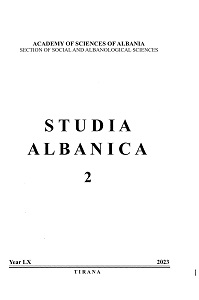MIGRATION MOVEMENT AS A DRIVING FORCE TO THE GROWTH OF CITY’S URBANIZATION IN ALBANIA
MIGRATION MOVEMENT AS A DRIVING FORCE TO THE GROWTH OF CITY’S URBANIZATION IN ALBANIA
Author(s): Godiva Rëmbeci, Armela REKA, Leonora HAXHIUSubject(s): Social Theory, Demography and human biology, Rural and urban sociology, Sociology of Culture, Economic development, Migration Studies, Sociology of Politics
Published by: SHKENCA Akademia e Shkencave e Shqipërisë
Keywords: migration; demographic indicators; population census; vital statistics; urbanization;
Summary/Abstract: Migration means the movement of people from one place to another, but mostly migration is considered the demographic process that links rural to urban areas, contributing to the growth of cities' urbanization. From a demographic point of view, internal migration shows the rate of change in the territorial distribution of the population during a certain period and is an important factor in determining the size of the regional population ’s stock at the end of the period. Furthermore, migration, as part of the demographic evolution of the prefectures, is a decisive indicator of social changes, including urbanization. Migration and urbanization have a strong effect on the economy, such as changes in labor market opportunities, education, health, environment management, governance, etc. So to better manage the migrationphenomenon, data on migration and urbanization are needed, but these data are not always available, especially in a systematic way. Since the '90s, ALBANIA has experienced huge external migration as well as massive internal migration flows. Compared to 1990, the current size of the resident population stock at the national level has decreased by about 12% due to emigration, accompanied by a decrease in the birth rate of about 65% and an increase in the death rate of20%. Internal migration is identified as a major factor in the demographic changes of the ALBANIAN population at the regional level, bringing in extensive urbanization in a few areas and a drastic reduction of population in the majority of the others. Based on the official statistics, it is estimated that about 26% of the resident population has changed its place of birth during the last three decades in ALBANIA. The most dominant migration trend in ALBANIA after the 1990s has been rural to urban, or more accurately, the suburban areas closed to Tirana city. The rapid growth of urban migration makes it necessary to carry out studies that will help government authorities understand the impacts of migration on the population and cities. This paper contributes to the studies that explore the demographic changes of the Albanian population during the last decades, focusing on internal migration movements and their impact on the urbanization of the cities. Data from the population ’s censuses of 2001 and2011 and vital statistics published by INSTAT will be used as a source of information to measure and analyze the size and direction of inflow and outflow of internal migration among prefectures, as well as its impact on the growth rate of a city ’s urbanization. Analyses show that the trend of demographic indicators at the regional level follows a similar path as the indicators at the national level, raising the awareness of policymakers on the necessity of using demographic and migration data in policymaking to guarantee sustainable development both at the national and regional levels.
Journal: Studia Albanica
- Issue Year: 2023
- Issue No: 02
- Page Range: 169-194
- Page Count: 26
- Language: English
- Content File-PDF

